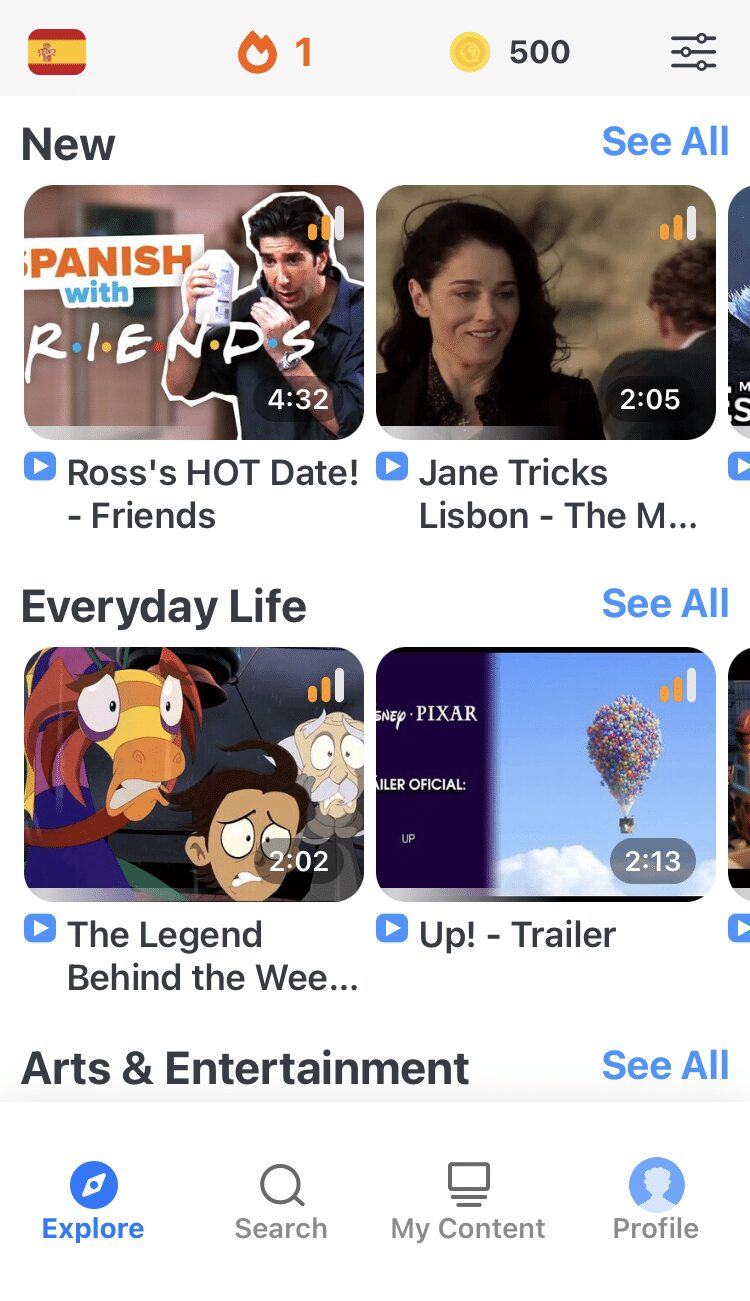Contents
- 1. Assess what happened in the past
- 2. Complete a language assessment to establish your starting point
- 3. Create a relearning schedule and stick to it
- 4. Retrieve your original study materials
- 5. Immerse yourself in the target language
- 6. Find a language exchange partner or tutor
- 7. Use flashcard apps for language flashbacks
- 8. Create a language diary/journal (and read it often)
- 9. Reach out to other language “relearners”
- 10. Read, watch and listen to children’s content in your target language
- 11. Prevent demotivation by focusing on your passions
- 12. Crack open a textbook
- 13. Teach others, so you won’t forget yourself
- To Relearn a Language, Understand Why You Lost It
- And One More Thing...
13 Practical Tips to Relearn a Language You Forgot

Thankfully, remembering a language you forgot isn’t the same as learning a language from scratch. You’ve just got to restore those language memories while also preventing the problems that made you forget the language in the first place.
I’ve been through this process, and I’ve got 13 practical tips that can help you remember your target language and get back on the road to fluency.
Download: This blog post is available as a convenient and portable PDF that you can take anywhere. Click here to get a copy. (Download)
1. Assess what happened in the past
Unlike a first-time learner who has no experience with the language whatsoever, you have a past. It’s time to take a sober look at your past experience and answer introspective questions, such as:
- What was your original motivation for learning the language?
- Why did you stop learning/using the language? (What difficulties or challenges made you stop?)
- What’s your motivation this time? Is it the same or different from the previous one?
- Why relearn it now? What changed?
Asking these sorts of questions before plunging into the task makes you more aware of (and therefore more prepared for) the pitfalls and challenges you might encounter. Lessons and insights from the past could help you pick learning strategies to make yourself a more effective learner.
For example, if you realize that reading textbooks didn’t work for you in the past, then you might look to employ more appropriate alternatives this time around, such as audiobooks, videos or language games. If you realize you were never getting any practical use of the target language, now you could look for some language exchange partners.
2. Complete a language assessment to establish your starting point
So, how much language proficiency did you lose over the years? Just how rusty did you get?
To find out, you need to take language assessment tests. First, take something I’ll call the “pre-test.” You take it for mainly two purposes.
One is to establish your present linguistic level, so you know your starting point. It’ll help diagnose those areas of the language that need more work. So use the results as a guide for your studies.
And second, the “pre-test” is something to measure against a “post-test”—the assessment you take after a few months in order to gauge how much improvement you achieved in the time between.
You don’t even need to physically go to a test center for these assessments. There are plenty of self-administered exams, drills and exercises online that can help you establish your present language level.
Check out Language Trainers’ Language Level Tests, for example. Write down your results and your experience in your journal (more on this later).
Don’t be surprised if tests and exercises suddenly function and feel like a review. You might find that as you move along and take more tests, more and more of the language comes back to you. (See? Told you it’s still in that head of yours!)
3. Create a relearning schedule and stick to it
How long is a reasonable time for you to be back in your old form? It’s really up to you, but make that determination early on. Give yourself a deadline, and a tight one at that.
Without a goal, without a time-sensitive objective, you might be lingering too long on a single lesson or topic. Instead, promise yourself to be back where you left off within a specific and tight timeframe and you’ll have a fire burning under you.
Suddenly you need to make a schedule to make the cut-off. Now you need to focus on the most important topics. Now you need to drop many unproductive uses of your time.
Only you can judge what a reasonable deadline is based on your work and personal life, but here’s a big tip to consider: break the whole thing into manageable tasks.
Relearning a language is a process and it can be broken into little language goals. It’s the little things you do that accumulate and carry you to your big goal. For example, you can set a deadline for when you’ll finish the first five chapters of a textbook, or the first five episodes of a language podcast. Set deadlines for memorizing different categories of vocabulary or the conjugation rules for a set number of tenses.
Plan several checkpoints along the way to confirm whether you’re moving in the right direction and at the right pace. The important thing is to keep building on your studies consistently and hitting your deadline so that you don’t forget the language all over again.
4. Retrieve your original study materials
Working with old materials is one of the ways you could help bring to the surface memories thought long gone. You’ll be reviewing something familiar, seeing your old annotations on the margins of pages, hearing the familiar voice of your old professor telling you, “repeat after me…”
It’s like meeting an old friend and realizing very little has changed over the years. It also adds to your confidence and makes you think, “If I’ve done this before, I know I’ll be able to do this again.”
Plus, you’ll save some money! Instead of buying sparkling new materials, search for those files, dig up the attic. Remember that slang and informal speech in the target language may have shifted over the years, but your materials on foundational concepts can still take you where you want to go.
5. Immerse yourself in the target language
You lost the language because you didn’t use it. It was so relevant for you when you spent that year in Spain and wanted to know where the ATM was. But now that you’re back in the U.S., not so much.
One of the most effective ways to relearn and relive a forgotten language is to immerse yourself in the language any way you can (incidentally, this is also true for learning a language from scratch).
Of course, it’s easiest if you’re visiting or living in a country where your target language is spoken, but not everyone can do that at the drop of a hat. Fortunately, you can get immersion from your own home with visual and auditory content in the target language:
- Visual: With today’s technology, you can easily consume native speaker content, accessing authentic movies, TV shows, broadcasts and video clips that are in the target language. If you’re trying to relearn French, for example, it won’t take you long to start watching French film clips on YouTube. The multimedia experience can make information much more memorable and mentally accessible.
One great resource for this type of learning is FluentU. It’s an awesome way to absorb authentic target language speech and entertainment while actively building your language memory.
FluentU takes authentic videos—like music videos, movie trailers, news and inspiring talks—and turns them into personalized language learning lessons.
You can try FluentU for free for 2 weeks. Check out the website or download the iOS app or Android app.
P.S. Click here to take advantage of our current sale! (Expires at the end of this month.)
- Auditory: In the same manner, radio programs, songs and podcasts in the target language abound online. You can listen to them through your smartphone everywhere you go.
So instead of listening to your usual music in the car, during your commute, you can play some songs in the target language. You can repeat until you’re able to sing along. Or some podcasts in the target language can do you good. Remember, you don’t need to understand every single word. You just need to be “in the moment” again. To go back to the sounds, rhythm and rhymes when you were hearing the target language everywhere.
There are many more ways to immerse yourself in your target language from home. For example, you can change the language setting of all your devices and social media accounts. You already spend hours on those, anyway, so imagine the amount of practice you’ll get. After a day or two you’ll be navigating your digital life intuitively in the target language, just like a native speaker.
You can also label the different objects in your house in the target language, so it’s always surrounding you. Check out Vocabulary Stickers, which take the busy work out of this process. These durable but removable stickers provide more than 100 target language words for objects you encounter every day.
By putting them all over your home, you’ll naturally start associating each object with its target language translation. This immersive type of learning is much more effective than, say, memorizing a long vocabulary list.
6. Find a language exchange partner or tutor
One of the fastest ways to brush up on your target language is to actually speak it. Talking to yourself is a good start but it’s really not enough. You need to use the target language in real-life communication. And there’s no better way than having a language exchange partner.
A language exchange works like this: let’s say you’re a native English speaker who wants to brush up on German. You’re going to have to look for a German native speaker who wants to brush up on English. So you trade languages, your English for his/her German. It’s a win-win! (And it’s free!)
There are a number of websites and apps that make looking for a language exchange partner very easy, no matter your target language. For example, you could check out websites like Conversation Exchange.
You can chat on the websites or talk to your language partner through Skype. The interactive nature of this experience is priceless to someone trying to resurrect a language. Your partner can help you with immediate feedback on your conversational skills and can also answer lingering questions about language usage.
If you want to take it a step further, and don’t mind shelling out some dough, you can go for online private tutoring. It’s often not as expensive as it sounds, plus it has the benefits of personalized and targeted lessons. Remember the online tests that you took earlier? You can gear your lessons specifically to those topics that you discovered need work.
One cool site to check out is Verbling. This online language learning platform will connect you with native tutors—you can browse thousands of profiles to find a tutor who matches your style and learning goals. Plus, the tutoring itself is friendly, conversational and user-friendly. You’ll use video chat on your computer or favorite device with Verbling’s built-in chat app. Start looking now for tutors who can meet your specific needs and help revive your forgotten language quickly.
7. Use flashcard apps for language flashbacks
Maybe you wouldn’t have forgotten words in your target language if, every once in a while, somebody reminded, prompted or prodded you on what a specific word meant. It would’ve been great if, just when you were about to forget something, somebody knocked on your door and said, “Hey, ‘dog’ is ‘perro’ in Spanish.” The language would’ve remained with you over the years.
That’s what flashcard apps are all about. Use them regularly and they’ll keep language concepts from slipping out of your memory. Some great ones to get started with are Anki and Brainscape.
These apps work like old-school flashcards but with some awesome innovations.
For example, let’s say you have a set of 20 French words to relearn. The app will show you the words and ask you to guess the translation written on the other side of the card. Depending on whether you answered correctly, the app will determine how frequently to show you the word in the future.
So the words you get wrong you’ll see more often, and the words you get right will be repeated less and less often. This is called “spaced repetition,” and it’s a super effective way to keep tabs on specific vocabulary that you need to work on.
The system isn’t randomized, but highly purposeful. You get to work on those exact words that you’re struggling with, but won’t be bogged down with words that you already know inside out.
The added benefit is that you likely won’t lose the language this time because the apps will make sure that the vocabulary is perpetually fresh, active and relevant in your mind.
8. Create a language diary/journal (and read it often)
Consider this a written commentary on your language journey.
Write daily in the target language, or at least every other day. Don’t ever think yourself too macho for these things. Getting your thoughts, insights and reflections on paper gives you extra awareness of what’s happening with your language studies—so you can do something about it.
It’ll point you to your weak areas, so you can focus on them. It can let you know what materials work, so you can use them more often. It can help you track your progress.
In other words, it can keep you moving forward successfully in your language studies, so you don’t get discouraged, quit and forget all over again.
You can write basically about anything. It doesn’t matter if it’s just a rant about something language-related. Is there a specific word that you can’t seem to remember? Are there grammar rules that you always get mixed up? (The act of writing itself already serves as a review.) Do you think the material you’re using isn’t working? Why? What did you and your language partner talk about today? What are the things that keep you from sticking to your language routine or schedule?
The time you spend thinking and writing is one of the most productive investments you can make. The act will pay dividends several times over.
9. Reach out to other language “relearners”
As a language relearner, you might think yourself alone in this quest. The process of brushing up on a forgotten language isn’t inherently sexy and it might even feel lonelier because you can’t categorize yourself clearly—it’s hard to know where you belong, as you’re not a language learner in the traditional sense. You’re a relearner, and what are the odds of finding someone in a similar position?
Well, as it turns out, your situation isn’t all that bleak or unique. There are plenty of people who are trying to resurrect and relearn a language. But where do you find them?
You’ll be hard-pressed to find forums or communities specifically dedicated to people relearning your target language. But those people do hang around traditional language forums, like WordReference, and there’s a way to find them.
Go to language forums like the one mentioned above, then use their search functions to look for posts and messages that contain words like “relearn,” “relearning,” “brush up,” “brushing up,” “rusty” and other words most language relearners use.
You’ll know your kind when you get to read their posts. You’ll read about the methods they’ve been using to resurrect a language. You can benefit from their knowledge and experience, so send them a “Hi!” (Don’t worry, they don’t bite and they know exactly what you’re going through.)
Another way to connect with relearners is to call them out. Start a thread and introduce yourself. Be forward, share your story and inform folks what you intend to do. Who knows, that might serve as a lightning rod that attracts people who are in the same boat. You could even start a support group and inspire one another.
10. Read, watch and listen to children’s content in your target language
Don’t think yourself too sophisticated for this kind of material. Kids’ shows and children’s books actually distill the things that you need to relearn in very digestible ways.
For example, a children’s book will contain the most basic of sentences that it’ll highlight for you the fundamentals of sentence construction. You’ll go, “Oh yeah, that’s right. That’s how you do it. It’s slowly coming back to me.”
The material won’t go over your head or overwhelm you. If you start off with something too complicated even for your former self, you might think your previous language skills have become irretrievably extinct.
So go easy on yourself, at least initially. Reading children’s books, watching children’s shows and singing along to the target language version of “Twinkle, Twinkle Little Star” will provide you with manageable material that can get you up to speed. Fast.
Trust that if these materials worked for young native speakers who later grew up and became fluent, they’ll also work for you.
11. Prevent demotivation by focusing on your passions
One of the reasons for self-assessment (as discussed in tip number one) and your language journal (tip number eight) is for you to have self-awareness and become more prepared for the downturns of language learning. These challenges are part of the territory.
Know that demotivating factors will always be around. They attacked you the first time and will once again come knocking on your door when you’re relearning the language. You’ll get discouraged, you’ll feel bored, all sorts of things. This is normal and you shouldn’t be surprised. You should instead be prepared.
So this time, look for more ways to get you through tough times. And one of the most potent ways to do that is through your passions and hobbies. Tie them up with your language goals and make them help you stay in the game.
But how?
Say that, besides wanting to learn Italian, you also love photography. If you integrate these two, you’ll get extra motivation to chase both.
For example, watching the “How To” videos of an Italian photographer whose portfolios you absolutely worship will hit two birds with one stone. You’ll be learning the finer points of your hobby while practicing a language that suddenly seems more fascinating and relevant than ever.
12. Crack open a textbook
Yeah, we know what others have said about textbooks. They’re often bad-mouthed in learning circles and considered ineffective or demotivating for most language beginners.
There may be good reasons for this, but hey, you’re no beginner. As a language relearner, you already have some inkling of what the grammar rules in the language are. You merely need to be reminded. And there’s no faster way to do this than with an effective, no-nonsense language textbook that plainly tells you, “this is how you conjugate this verb or that verb, remember?”
Barron’s “E-Z” language series gets to the point fast and contains very little fluff—true to form as a leading name in test prep.
It just really saves you so much time. Think about it this way: a textbook provides nice and handy condensations of what you may already know (mixed with some things you don’t).
As you’re exploring authentic content in your language or using other study tools, you can quickly look up grammar rules or vocabulary words that have slipped your mind in your textbook.
13. Teach others, so you won’t forget yourself
Part of the reason you “lost” your target language was because you weren’t using it often. This time around, actively look for opportunities to stretch those language muscles. Teaching others is one of the most effective ways to remain sharp.
You don’t have to create a teacher profile on some language tutorial site. You just need to be on the lookout for others who want language help. So maybe while you’re browsing a forum you happen to chance upon some language question that you know the answer to. Take the time to share that knowledge, no matter how small or simple it may be.
A Language Learners’ Forum, for example, is steadily growing and has lively discussions on many linguistic subjects. Join the conversation and share what you know.
The process of teaching can be very educational. Explaining what you know cements that knowledge firmer into your long-term memory (and can sometimes reveal gaps in your own knowledge, if you realize you actually can’t answer someone’s question or explain a certain concept).
There’s just something about being responsible not only for your own learning but also for another’s that makes you work even harder at the language. It sparks extra motivation in you to be able to explain how the language works. You get that extra research in because you don’t want to teach something that’s wrong. So you double-check online, reread your materials and even ask people more advanced than you.
To Relearn a Language, Understand Why You Lost It
Why don’t we go back even further and look into some reasons why you started learning the language at all. And not just for kicks—this will tie everything together, make us see the bigger picture and help us understand why and how things unravel.
First, let’s talk about motivation. When it comes to language learning, this one’s a biggie. It’s the engine revving under any language learning journey. Let’s look back to when you asked yourself, “what language should I learn?”
So, what was your motivation for learning the language in the first place? It might be as strong as a passion for German film, or as flimsy as a required French course in college. Maybe your heart suddenly skipped a beat after seeing this Italian girl, and all you could think of was to pawn yourself off as a suave Italian lover. Or maybe it was the hopes of a promotion or an assignment overseas.
Your motivation is so important because once you lose it, well, it’s really downhill from there. Maybe the girl you’d been pining after turned out to be so not into you. Maybe you finished your French course, so you nonchalantly chucked all those flashcards in the trash as soon as you got your grade.
Or perhaps yours was a situation of immigration, where your parents decided to move to the U.S. when you were five, and you became so Westernized you forgot what real wasabi tastes like. You now have your English, in lieu of your first language, Japanese.
There are many reasons for forgetting a language. But believe it or not, they all lead to the same problem: disuse.
In short, the target language has so lost its communicative relevance, you stopped using it. Simple as that. You forgot a language because you didn’t use it. Compound that with the passage of time, and those vocabulary and grammar lessons seem irretrievably lost.
And so we now arrive at a linguistic crime scene—that of a dead language. But is it really dead? Or can it still be brought back to life?
Well, the good news is, research indicates that lurking in your brain are the memories of the language you thought forgotten. They’re the vocabulary, grammar and usage rules you learned that are just awaiting reactivation. It may not be 100 percent recall, because there are things you truly forget with the passage of time, but there are also those that remain, even when you’re unconscious of them.
This means that when relearning a language, you don’t really have to start from square one, and a single word can trigger a flood of memories. You could be up to speed faster than you think.
The fact that you’ve dealt with the language in the past is a huge plus. You have an improved ability to pick it up once again (over those who haven’t been exposed to the language previously). So it’s not completely a matter of “use it or lose it” after all. It’s more about retrieval and reactivation.
So there you go! Thirteen little gems to help you resurrect a dead language. I trust that you’ll apply them in your own case. And I’d like to wish you the best of luck. I’m rooting for your success. To me, reviving a forgotten language—having a go at it a second (or third) time—is one of the most awesome things you can do.
Tell us how it goes!
Download: This blog post is available as a convenient and portable PDF that you can take anywhere. Click here to get a copy. (Download)
And One More Thing...
If you dig the idea of learning on your own time from the comfort of your smart device with real-life authentic language content, you'll love using FluentU.
With FluentU, you'll learn real languages—as they're spoken by native speakers. FluentU has a wide variety of videos as you can see here:
FluentU has interactive captions that let you tap on any word to see an image, definition, audio and useful examples. Now native language content is within reach with interactive transcripts.
Didn't catch something? Go back and listen again. Missed a word? Hover your mouse over the subtitles to instantly view definitions.
You can learn all the vocabulary in any video with FluentU's "learn mode." Swipe left or right to see more examples for the word you’re learning.
And FluentU always keeps track of vocabulary that you’re learning. It gives you extra practice with difficult words—and reminds you when it’s time to review what you’ve learned. You get a truly personalized experience.
Start using the FluentU website on your computer or tablet or, better yet, download the FluentU app from the iTunes or Google Play store. Click here to take advantage of our current sale! (Expires at the end of this month.)











